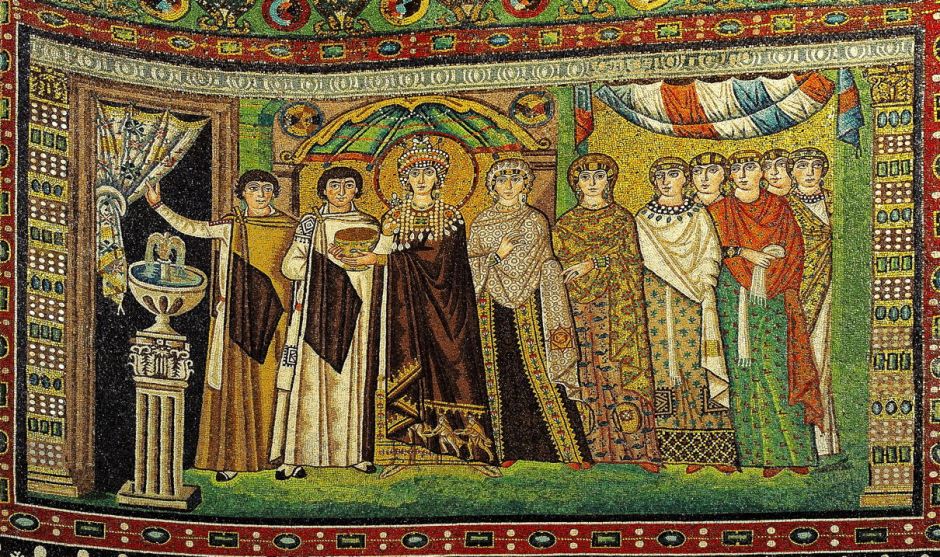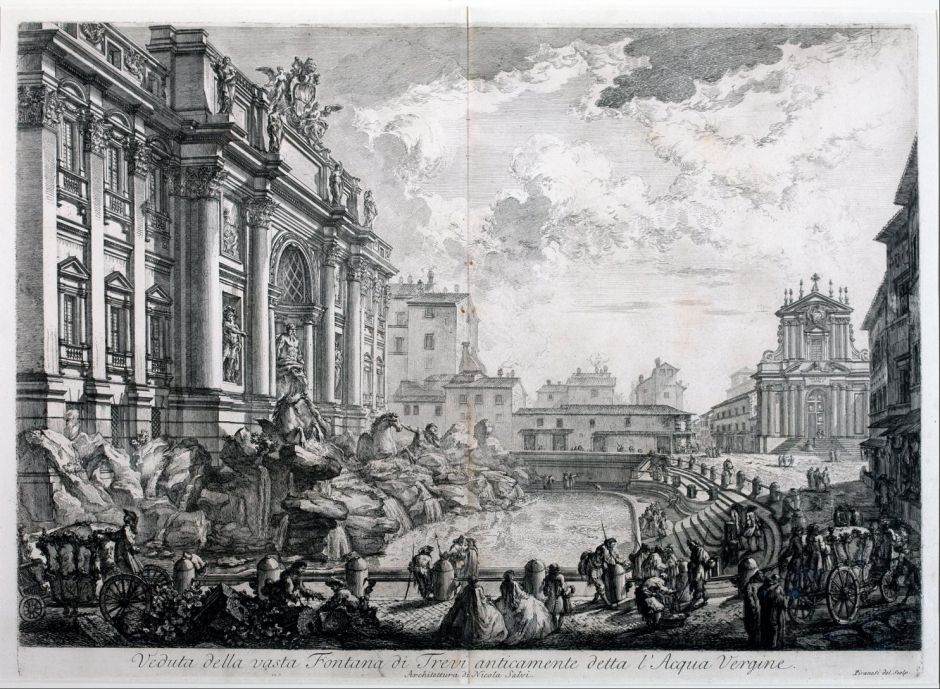Fountains were originally natural springs which were controlled to deliver water in a manner that makes their supply more accessible. Instead of trickling away into a stream, their jet of water is entrained so we can drink from it, or fill containers. Without water there can be no life, so fountains are seen as delivering the water of life, an important role particularly in more arid environments.
In this article and its sequel tomorrow, I look at a selection of paintings which include fountains, and consider their reading.

This exquisite mosaic of Theeodora in the Basilica of San Vitale features a fountain at the left. Not only does this symbolise the fountain of life, but it was probably blessed to provide holy water.

This well-known panel of the Adoration of the Lamb from the van Eyck brothers’ Ghent Altarpiece includes in its foreground an elaborate fountain. While this has symbolic links to a baptismal font, its primary interpretation is as the fountain of the water of life.

Jan van Eyck’s later Madonna and Child at a Fountain from 1439 develops this symbol further, with even greater elaboration, as shown in the detail below. Each jet of water starts off almost transparent, with the merest hint of white, and becomes progressively whiter and more opaque as it falls into the water below.


When it comes to elaborate fountains, there’s none better than Hieronymus Bosch. The left panel of his Garden of Earthly Delights (c 1495-1505) shows an innovative view of the Garden of Eden divided into tiers as it recedes into the background. The foreground is dominated by a scene from the account of the creation of man in Genesis, in which God has just created Eve, and introduces Eve to Adam. In the middle of a lake behind them is a multi-level fountain which appears to have grown from a strange form of plant.

Fountains are featured extensively in literature. One of the better-known tales from Boccaccio’s Decameron concerns Cimon and Iphigenia, who first meet when Cimon is out walking one afternoon in May. When he reaches a clearing among tall trees, he sees the beautiful Iphigenia asleep on the grass beside a fountain.
In about 1617, Peter Paul Rubens joined talents with Frans Snyders (who painted the still life with monkeys at the lower right) and Jan Wildens (who painted the landscape background) in their marvellous Cymon and Iphigenia. This is accurate in its details too, with the correct quota of attendants, and a splendid fountain at the left. Cimon really looks like the uncouth simpleton in Boccaccio’s account.

In about 1635, during his late career, when he had officially ‘retired’, Peter Paul Rubens painted Bathsheba at the Fountain. Bathsheba looks dreamily into the distance as her hair is combed and prepared by a maid. At the far right is another piscine fountain.
So far fountains have been rather special, either directly associated with life-giving water, or indicative of special places such as those used to cool off and rest. They also had a more mundane function as one of very few sources of fresh water.

Giacomo Ceruti made his reputation for painting the poor of Brescia, in Italy, and The Laundress, from about 1736, probably shows a scene from that city in Lombardy. A middle-aged woman, wearing ragged working clothes, is laundering at a communal fountain. She fixes the viewer in her steely glare for a moment, as a ragged youth stands behind, holding a stick over his shoulder with more washing on it.

In the mid 1740s, Tiepolo painted two accounts of Flora, the first being The Empire of Flora in about 1743. She is here seated in a chariot being drawn by winged cupids or winds, brazenly showing off her naked body like a down-market version of Venus. This was commissioned for Augustus of Saxony, whose residences featured a hanging garden and Neptune fountain designed by Lorenzo Mattielli. To please his patron, Tiepolo had to include them both in his painting, putting one fountain in the left distance, and another at the top right.

If you’ve ever visited Rome, a city still renowned for its fountains, you’ll surely recognise the famous sight of a Side View of the Trevi Fountain, one of the prints included in Piranesi’s hugely successful Views of Rome, in 1747-48. The largest fountain in the city, it dates from 19 BCE, when it was built at the end of the Acqua Vergine aqueduct. Work to create the modern version had started in 1732, but had been interrupted, and wasn’t completed until 1762. That accounts for some of the sculpture being incomplete.
Rome has fifty monumental fountains, and hundreds of smaller ones. They have inspired artists, composers including Respighi, and even movie makers in films such as Three Coins In the Fountain (1954).

Pierre-Henri de Valenciennes’ Classical Landscape with Figures Drinking by a Fountain from 1806 is an idealised landscape founded on several of his plein air oil sketches of the Roman Campagna. This is another fountain where you cool off and drink during the heat of the day.

When Thomas Cole painted his series of The Course of Empire in 1836, it was only natural that his idealised classical port should feature ornate fountains when at its height, in The Consummation of Empire.
As a source of drinking water, modest workaday fountains were the place that women visited to fill their household’s water jars for the day.

William Morris Hunt painted Girl at the Fountain (1852–54), when he was learning the Barbizon style with Millet, near Paris.

A fountain features in Goethe’s Faust. Ary Scheffer’s Margarete at the Fountain is thought to have been completed shortly before the artist’s death in 1858, and shows the ill-fated Gretchen fetching water from the local fountain.
Tomorrow I’ll show some paintings of fountains from the late nineteenth and early twentieth centuries.

